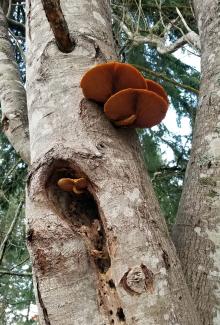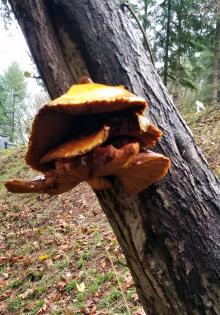Cause Two types of wood decay occur in living trees: white rots and brown rots. White rots appear to be more common in willow and are caused by Daedalea confragosa (soft white rot), Phellinus igniarus (white trunk rot) and Polyporus squamosus (white mottled rot). Ganoderma applanatum has also been found. Fruiting bodies of a Gymnopilus sp. has been collected in Oregon on Salix hookeriana and S. scouleriana. White rots cause all major structural components of the cell wall-cellulose, hemicellulose, and lignin-to degrade. The strength of white rotted wood decreases only in advanced stages of decay. Infection occurs through branch stubs and wounds. Conks usually develop in these same areas.
Injuries from pruning cuts, sunburn, or storm damage can expose susceptible wood. Large wounds and stubs and horizontal cuts are often entry sites for decay fungi. Wood decay generally is observed in older trees after extensive fungal colonization. Decay fungi frequently function as secondary invaders following a succession of microorganisms, including bacteria, yeasts, and other fungi. Decay in a single tree may be caused by more than one fungal species. Live trees are able to limit wood decay by walling off and compartmentalizing decay fungi but this can vary between different species and individuals. The CODIT model/principle (compartmentalization of decay in trees) is used by certified arborists to manage landscape trees with decay.
Symptoms White rots cause moist, soft, or spongy wood that is a lighter color than sound wood. Fine black lines may run throughout the decayed area.
For Daedalea confragosa, the decay is indistinctly mottled, and faint, brown-zone lines may be present. The annual conks are leathery, shelf-like, and up to 6 inches wide. The upper surface is gray to brown, smooth, and concentrically zoned. The under surface has irregularly elongate, coarse pores, which sometimes almost appear gill-like.
The conks of Phellinus igniarus are also hard, woody, and usually hoof shaped. The upper surface of young conks is grayish-black and smooth, but with age this surface becomes rough and cracked.
For Polyporus squamosus, a white mottled rot of the heartwood is produced. The sapwood may also be invaded. The annual fruiting bodies are large, measuring up to 20 inches in width, and have a short, thick, lateral stalk, which is black at the base. The upper surface is whitish yellow and covered with darker scales. The pores in the lower surface are large (three to six per inch) and angular.
Each of these wood decays leads to limb breakage and/or uprooted trees during wind or ice storms. Many trees have decreased vigor and dieback.
Cultural control
- Avoid wounding trees to prevent decay. For example, mowing equipment should not injure the roots, crown, or lower trunk.
- Make pruning cuts adjacent to, but not into, the supporting branch, and prune when branches are small to enhance callus formation and wound healing.
- Irrigation water, especially from sprinklers, should not wet the trunks.
- Inspect trees for decay and/or conks to assess tree stability.
- Remove affected trees to avoid damage to surrounding property or spread to other trees.
References Shaw, C.G., and Harris, M.R. 1960. Important diseases and decays of trees native to Washington. Ag Extension Service, WSU. Extension Bulletin 540.




